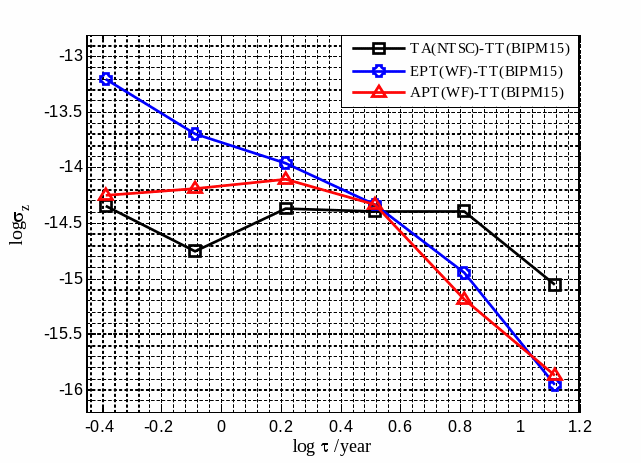A research team led by Prof. TONG Minglei from the National Time Service Center(NTSC) of the Chinese Academy of Sciences(CAS) has made important progress in the research on the joint timing of pulsar time and atomic time.
Researchers applied the comparison data between pulsar timing observations and atomic clock sets to establish a fusion time scale APT (Atomic-Pulsar time) that takes into account the advantages of both long-term stability of pulsar time and short-term stability of atomic time.
This work were published in Monthly Notices of the Royal Astrological Society under the title "Research on establishing a joint time scale of Pulsar time and atomic time based on wavelet analysis method".
"The current standard time mainly relies on atomic time, which has the characteristic of high short-term stability. Pulsar time and atomic time have completely different physical mechanisms from atomic time, and have a significant advantage of high long-term stability over years", said Prof. TONG.
ZHU Xingzhi and ZHANG Zhehao, the main member of this research team, utilize wavelet analysis methods to perform multi-scale analysis of pulsar time and atomic time signals in both time and frequency domains, assigning corresponding weights to different frequency bands for synthesis, and combining the advantages of both. Based on the latest observation data released by the International Pulsar Timing Array, an ensemble pulsar time EPT (WF) was established using the Wiener Filter (WF) algorithm, and then combined with the atomic time TA (NTSC) independently maintained by NTSC to obtain the APT (see Figure 1). The short-term stability of APT is similar to that of TA (NTSC), and after sampling for more than 3.2 years, its stability is consistent with that of pulsar ensemble time. The stability at 13.1 years can reach 1.3 × 10-16 (see Figure 2).

Figure 1: Clock differences of EPT (WF), atomic time TA (NTSC), and APT relative to TT (BIPM15) published by BIPM.(Image by ZHU Xingzhi)

Figure 2: The stability of EPT(WF) based on 16 pulsars, atomic time AT, and APT.(Image by ZHU Xingzhi)
APT, as a new "paper time" with both long-term and short-term stability advantages, is independent of the international standard time UTC. When international comparisons cannot be carried out normally, it is expected to serve as a reference for steering the national standard time UTC (NTSC), solving the problem of long-term maintenance of national standard time, and improving the reliability and stability of national standard time.
"This research laid the foundation for the joint timekeeping of pulsars and atomic clocks in the future", said Prof. TONG.
CONTACT:
XIONG Tiantian
National Time Service Center, Chinese Academy of Sciences
gjhz@ntsc.ac.cn
 Print
Print